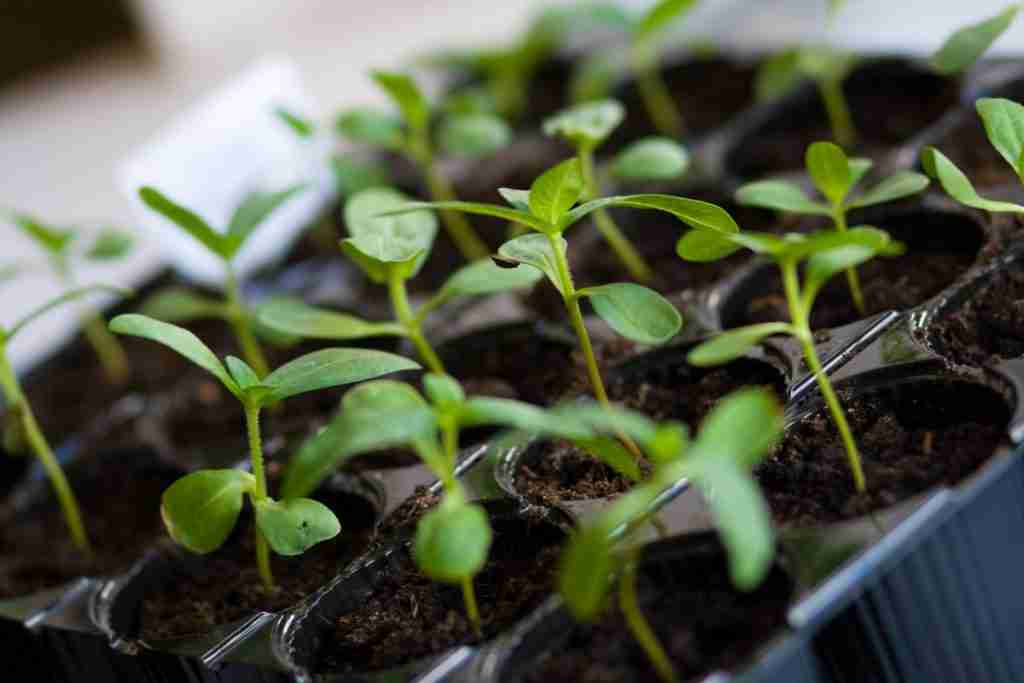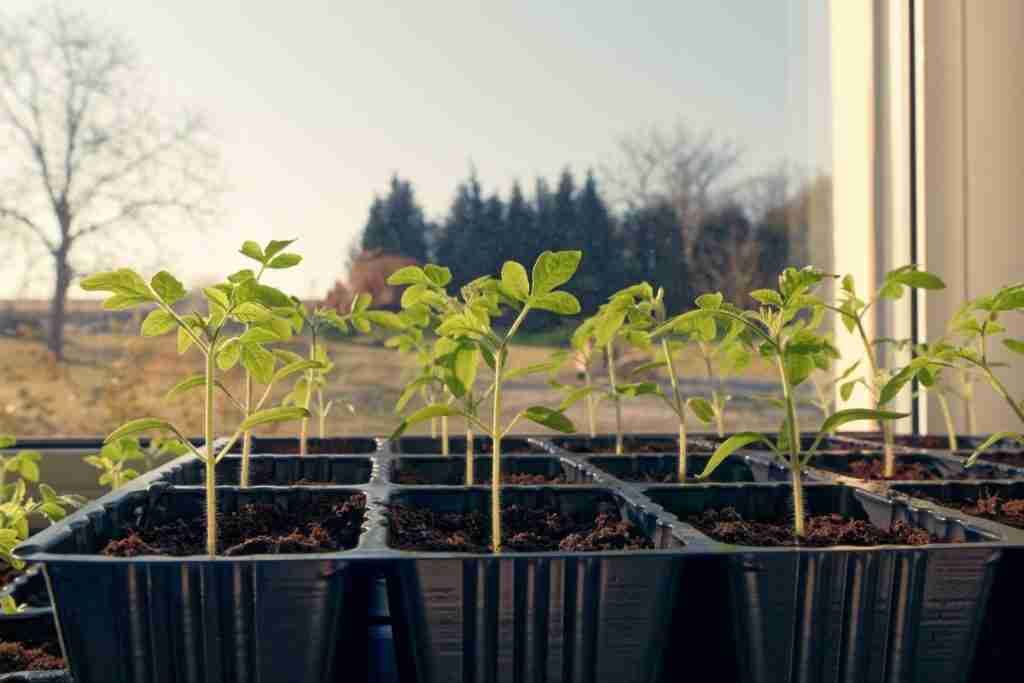
When growing seedlings, there is nothing more important than providing them with the proper amount of light. To do this, you must first understand the best time to introduce them to the bulb.
Seedlings should go underneath artificial lighting at the first signs of sprouting from the shell. These baby plants require 14-16 hours of constant light each day.
Providing enough light seems like a pretty simple concept, right? Well, there is a lot more to it than you might think.
Table of Contents
When Do I Put My Seedlings Under Lights?
Once you see your little seedlings start to sprout, they should go right under the grow light you have set up for them. From the moment they are “born,” they require ample time under the light to thrive.
Grow lights are an amazing tool many indoor gardeners use to ensure their plants reach their full potential, even when the environment isn’t necessarily ideal.
The majority of plants rely on the sun for natural light and the process of photosynthesis. Photosynthesis is how vegetation creates its own food, providing the plant with most of what it needs to grow properly or at all.
Without a good light source, your seedlings won’t stand a chance at survival. So, if you can’t offer them many hours a day soaking in the direct sun, a grow light is the next best thing.
10 Important Tips for Lighting Your Seedlings
Once you see your tiny seedlings emerging from their shell, it is time to place the seed tray underneath your grow light. While it may seem like a pretty straightforward process, there are a few things you need to know to ensure things go smoothly.
1. How Much Light
As mentioned above, your little ones need the same amount of light as they would obtain from the sun daily. This means providing them with proper lighting for 14-16 hours a day (maybe a little longer, depending on the plant).
2. Provide a Light Source from Sun Up to Sun Down
Plants, like humans and many animals, like to have downtime at night when things get dark to rest, relax, and regenerate. You can shut the plant light off at night (once the sun goes down). Then flick on the switch first thing in the morning.
3. Choose the Best Light Source for Seedlings
There are tons of different types of lightbulbs out there, but they are not all ideal for helping your seedlings grow.
Go to your local nursery or farm and tractor supply store and look for fluorescent light bulbs specifically designed for plant growth. If you don’t trust making your own light source, you can always purchase a kit to get you started.
4. Utilize the Sun
Unfortunately, even if you have a large window that provides access to the sun, it probably won’t be enough to assist your little seedlings as much as they need. However, it can be a good way to help offer them a small source of natural lighting and soak up the rays.

5. Too Bright Is Too Much
Multiple types of lightbulbs help your young plants grow and thrive. However, some are much brighter than others, so you must be careful when choosing the right option for your seedlings.
- LED Grow Lights – LEDs offer a wide range of coverage but don’t generate very much heat, requiring them to be closer to the plants.
- Fluorescent Lights – Fluorescent lights give off much more heat but can overheat one area and not provide enough heat to another if positioned incorrectly.
6. Distance Is Everything
When placing your seed tray under the grow lights, you want to ensure they are not too far away but also not too close.
If the tray is too far from the light, you won’t get the results you are hoping for because the seedlings aren’t getting enough resources to feed and fuel themselves. Your new plants will stretch, and each leggy seedling will try to reach the light source and wither.
On the other hand, if your young plants are too close to the grow light, there is a good chance it will bleach your plant’s leaves and even scorch them. At this stage, that could be extremely detrimental.
Distance of Height According to Bulb Size
| HID | LED | Fluorescent |
| 400w: 13-20 inches 600w: 15-25 inches 1000w: 20-30 inches | 210w to 400w: 15-30 inches 450w to 550w: 20-30 inches 600w to 850w: 24-26 inches 900w and up: 26-40 inches | T5: 12-15 inches CFL: 15-20 inches |
7. Adjust According to Size
Your grow lights should always stay the same distance from your plants, no matter what stages they are in. As your seedlings grow, you will want to adjust your lighting accordingly, raising it up the taller they get.
8. Don’t Forget to Water
Watering your seedlings is just as important as providing proper lighting. It is even more important at this time because of how much heat these bulbs emit.
The warmth given off by these grow lights can quickly dry out your soil, in turn dehydrating your seedlings, which will end up stunting their growth and even killing them.
9. Too Much Light Can Lead to Trouble
Granted, you must keep your grow lights on for almost three-quarters of the day; however, forgetting to shut them off at night can potentially be fatal.
Too much light can affect plants even before they sprout, causing irreparable damage even as seeds. Always make sure to shut your lights down at night and to keep an eye on them during the day until your plants are viable.
10. Keep Your Lights on During the Day
It can be extremely tempting to flick off your light source during the day when you have the chance to stick the tray in front of the window for a few hours on a sunny day. However, this isn’t always a great idea. In fact, it can ruin everything you have worked for up until now.
Your plants will adjust to the environment you create for them inside your home; this includes the source of lighting provided for them. If you decide to shut off the lights, the plants won’t get the same consistent light they have grown accustomed to.
Benefits of Providing Light to Your Seedlings
So, you live in a location with a naturally warm climate, with plenty of sunshine and daylight hours. Should you still implement the use of a grow light?
The simple answer is yes. Even with plenty of sunlight available, there are many benefits to using artificial lights for starting seeds indoors.
- Grow seeds from anywhere: With a grow light, you won’t have to clutter up your window space. These lights will work from anywhere in your home, making it easy and convenient to spout your favorite plants from seeds.
- Stronger and healthier seedlings: Seedlings placed under an artificial grow light tend to grow stronger and healthier than the ones that simply sit on a window sill.
- Better chance of survival: Most experienced gardeners will tell you they have a much higher survival rate of plants placed under grow lights compared to those that are not.
- Save time and money: You can save a lot of time with grow lights, helping your plants bloom quicker. You can also save money when you aren’t required to re-pot new seeds after the first set doesn’t survive due to a lack of lighting.
- Less stress: Turning on a grow light is easier than moving the plants from the window every night and back the next day. This means less work for you, and your plants are still well taken care of.

Tools to Add to Your Grow Kit to Aid in Healthy Seedling Growth
Having a good grow light will get you pretty far when planting and growing seedlings. However, with a few other helpful tools, you can make the process a little easier and more effective.
- A timer: Purchase an automatic timer to add to your grow lamp to ensure your growing plants get the proper amount of lighting they need daily (and you don’t have to worry that you might forget).
- Good pots: Most pots on the market will suffice; however, purchasing pots with proper drainage and ones that you can transport from one location to another can make your life much easier.
- A watering can: Water is water, but having a quality watering can on hand ensures you remember to water your seedlings on time, every time.
What Is the Best Soil for Seedlings Under Lights?
Because the lighting is warm, it is going to affect the soil and the moisture in the soil. For these reasons, purchase soil specifically made for seedlings.
The best soil to add to your seedlings’ pots is a lightweight, hydrated mix with excellent drainage. Because these little plant roots are still weak, they require soil that will allow them the ability to push through with ease.
It is also a good idea to purchase soil with organic fertilizers or add organic materials on your own, preferably those that retain moisture.
When picking soil for your seedlings, look for products that include materials such as peat moss, perlite, vermiculite, or coconut coir fiber.
Your seedlings might also benefit from soil that includes diatomaceous earth, which can hinder bugs from bothering your baby plants and killing them before they have a chance to mature.
Summing Things Up
The right amount of lighting and perfect timing is just as important to the seedlings as how much water and nutrients you give them. Putting your seedlings underneath the best form of light from the moment your seeds sprout will play a major role in how well they thrive.

When Do I Put My Seedlings Under LED Light?
Monday 13th of November 2023
[…] they receive adequate nutrients for photosynthesis. By following this guideline, you’ll give My Seedlings Under LED Light, helping them thrive and flourish into healthy, mature plants ready for transplanting into your […]
Top 10+ When Do I Put My Seedlings Under Light
Sunday 4th of September 2022
[…] Source: 🔗 […]